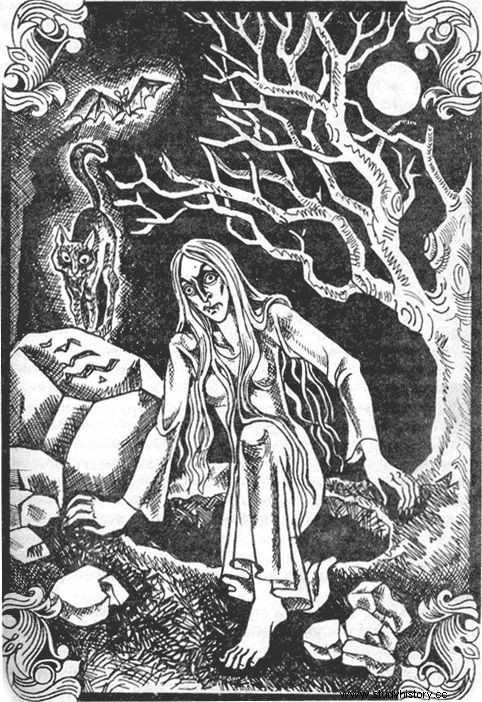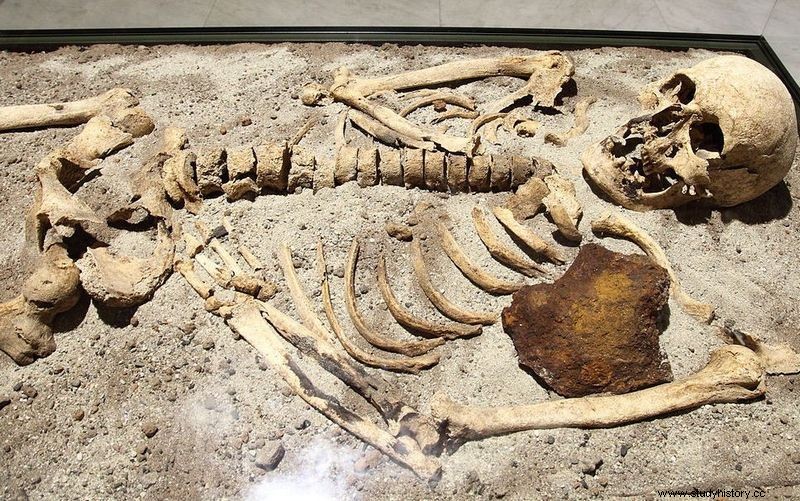In movies, the matter is almost always taken care of by the axen peg. Our ancestors were much more inventive. Here are the ways in which people have really resorted to - for hundreds of years all over Eastern and Southern Europe.
The roots of the vampire myth are lost in the mists of time. It seems that the Slavs believed in these cunning beasts from the earliest times. Bloodsuckers were told in peasant huts in the era of pagan idols, but also centuries after Christianization.
It was a common belief that impure forces could possess a dead body, bringing it back to life in part. Vampires were to be primarily people marked with the stigma of corruption:thieves, murderers, drunkards, vagrants and suicides. According to folk traditions, they got up at night to suck blood, but also spread disease, kill pigs, or even cause plague epidemics.
People of the Middle Ages and the modern era did not believe that a vampire could be defeated when he went out to feed. They preferred ... subversive activities to the spectacular fights we know from novels and movies.

According to Slavic folk tales, it was impossible to fight vampires at night. They had to be approached (source:public domain).
In the light of legends and peasant customs, you had to sneak into a vampire's lair during the day when he was asleep and completely defenseless. What's next? The tutorials varied in detail, so here are some of the most popular methods. And those that - in the light of archaeological research - were really used.
If you come across a sleeping vampire…
Give him… iron. In the world of fiction, silver is an infallible antidote to the monsters of the night. Ordinary medieval peasants did not have access to silver witcher swords, or even - they did not dream of similar accessories. In authentic folk beliefs, it wasn't silver, but simply iron that killed vampires.
Pierce his heart with ... a rod. Iron could cover a coffin, but people who wanted absolute certainty did not limit themselves to similar half-measures. In 2014, a 13th-century tomb was discovered in southern Bulgaria, in which - at least in the opinion of contemporary people - a vampire must have been buried. The torso of a man who died at the age of about forty was pierced by cordial neighbors with a thick rod taken from a plow. The impact was so strong that it crushed one of his shoulder blades, and on the way it no doubt pierced his heart.

An iron rod on the heart. A proven way to deal with vampires. The photo shows an 800-year-old vampire burial from Bulgaria (photo:Bin im Garten; license CC BY-SA 3.0).
This particular "vampire" was no exception. In Bulgaria alone, at least one hundred similar burials have been found so far. Even the great-grandparents of today's Bulgarians still pierced vampires' hearts, because archaeologists sometimes dig up corpses with bars in the chest, buried not earlier than in the 20th century.
Don't let him leave. A vampire could be humanely killed by piercing his heart, but it could also be condemned to a slow and painful death by starvation. And it was an option almost as popular as simple heart piercing.
For example, the body of a man buried on the Greek island of Lesbos in the Middle Ages was pinned to the ground with three solid iron bars. They were inserted through the neck, pelvis and ankles. Such a pinned bloodsucker had no chance of going hunting at night.
In the absence of a hammer and nails, the body could also be simply sprinkled with stones, and the limbs could be tied up or… chopped off. The inhabitants of Celakovice, a settlement situated thirty kilometers north of Prague, for example, knew about it. Around the twelfth century they faced the real scourge of vampirism. As many as fourteen young men and women who died as a result of the epidemic were given both a packet of nails and - piles of heavy stones.
Feed him a brick. In Kashubia (and not only), stories were popular, according to which vampires first feed on their own funeral shroud, and only when they devour it - they set off in search of more victims. There was a simple way to deal with similar journeys. The tomb of a dead body that was too mobile was opened and bricks, stones, or even earth were put in his mouth. It was believed that the young vampire, deprived of a source of vitality, would gradually weaken, and if he fed only on bricks, he would inevitably starve to death.The grave of the unfortunate man, who was treated in this way, was recently discovered in Kamień Pomorski. However, similar burials took place even in distant Venice. Make him a farmer. The vampire could also be pinned to the ground using an item with magical powers. And it didn't have to be any sophisticated amulet at all.

A vampire hunting kit on display at the Mercer Museum in Pennsylvania. Our ancestors dealt with vampires using much simpler methods (photo:Ola10; lic. CC BY-SA 3.0).
In old Poland it was believed that to completely immobilize a bloodsucker it was enough to put a sickle on his chest (or around his neck). The most common tool available in every peasant cottage. And the method actually worked, because the sickle skeletons, which archaeologists found in 2009 in the medieval cemetery in Drawsko, look completely, completely dead ...
Try to make him lose his head. In the event that the sickle was not enough, the vampire could be deprived of access to the fangs. Chop my head off and it'll be over. One method involved hanging the suspicious body upside down and leaving it standing until it completely rotted and the head dropped off. Only then - with complete peace - could they be buried.
This is probably what was done with the four men buried in the 16th century near Gliwice. A headless body rested in every grave. The heads themselves, on the other hand, were placed between the skeletons' legs.

The church in Prostějov and the chapel of the Holy Cross (on the left). It was there that the vampire burial was found (photo:Pernak; license CC BY-SA 3.0).
Bury him… in the church. Most often, care was taken to keep the vampire as far away from places of worship as possible, but not always. There are known cases when the corpses of people suspected of the posthumous career of a blood-sucking monster were deliberately buried as close to the altar as possible. It was believed that the special sanctity of such a place would prevent the bloodsucker from wandering at night.
This is what the eighteenth-century inhabitants of Prostějov in Moravia seem to reasoned. In 1998, in one of the chapels of the local church of the Exaltation of the Holy Cross, the undoubted "vampire burial" was unearthed. Iron reinforced coffin, legs chopped off, and stones stacked in the coffin. And that's all… right under the presbytery floor.
Bibliography:
- M. Affleck, 8 Recently Discovered Medieval Vampire Burials , "Listverse", April 4, 2013.
- D. Barrowclough, Time to Slay Vampire Burials? The Archaeological and Historical Evidence for Vampires in Europe , October 9, 2014.
- T.K. Betsinger, A.B. Scott, Governing from the Grave:Vampire Burials and Social Order in Post-medieval Poland , "Cambridge Archaeological Journal", 3 (24), 2014.
- M. Day, Polish archaeologists unearth "vampire grave" , "Telegraph", July 11, 2013.
- M. Day, H. Alexander, "'Vampire grave" found in Bulgaria , "The Telegraph", October 10, 2014.
- L.A. Gregoricka, T.K. Betsinger, A.B. Scott, M. Polcyn, Apotropaic Practices and the Undead:A Biogeochemical Assessment of Deviant Burials in Post-Medieval Poland, "PLoS ONE", 9 (11), 20214.
- Pavel Moš, Ve městě prý řádil upír, tak ho v rakvi rozekali , " Prostějov ý denik.cz ”, February 11, 2011.
